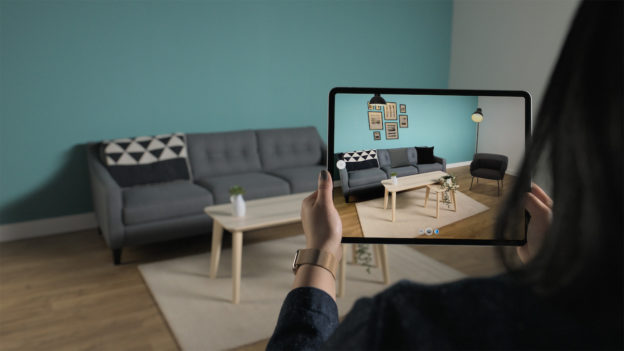As Micro LED is yet to enter commercialization due to layers of technical difficulties and exorbitant cost, Mini LED has already been successfully incorporated into the application of commercial operation, and has made its presence in the application field of high-end display such as commercial and gaming monitors, including the Mini LED gaming notebook of MSI, as well as the gaming monitors of Asus, Acer, and Lenovo. Now, the industry is anticipating Apple to release multiple iPads and MacBooks adopted with Mini LED backlight technology between 2H20 and 2021 that would lead the trend in officially propelling the Mini LED backlight technology into the mainstream display market.

(Image: Apple)
Mini LED Backlight Technology Advantages and Industrial Chain Division
Compared to traditional backlight, Mini LED backlight technology is able to substantially increase contrast and resolution, and introduce revolutionary improvement in LCD monitors, of which the local dimming technology is the essence in creating high contrast and resolution.
The more local dimming zones the backlight has, the more delicate the rendered picture effect, and the adoption of more LED dices naturally. The 17.3-inch gaming notebook of MSI uses 240 local dimming zones, where the 32-inch Mini LED monitors of Asus and Acer, as well as the 27-inch monitor of Lenovo, all adopt 1,152 local dimming zones, with more than 10K Mini LED chips used.
A synergistic cooperation between each professional technology manufacturer on the supply chain is required for such sizeable amount of Mini LED chips to be integrated onto a monitor, and synchronize with the LCD screen.
LED chip manufacturers, including Taiwan-based Epistar, Lextar, and Epileds, and Japan-based Nichia, as well as Germany-based Osram, are subtly developing LED chips. Furthermore, Chinese chip manufacturers, San’an and HC Semitek, have been developing the relevant technology of Mini LED and Micro LED over the past two years under the considerable investment from the government. A number of LED packaging houses, including Everlight, ProLight, AOT, and Nationstar, are inclined to penetrate into the Mini LED backlight market through the existing die bond and mounting production lines, as well as the provision of Mini LED packaging.
Due to its smaller dimension compared to traditional LED, Mini LED requires an elevated precision in the equipment required for the transition and the mounting process, as well as escalated requirements in the subsequent inspection and sorting. ASM Pacific and K&S that specialize in high speed transition technology, and FitTech that provides subsequent sorting and inspection, are also in the limelight. Manufacturers that produce backlight modules include Radiant, as well as related enterprises of Korean manufacturer LG, HeeSung, and Qisda.
Supply Chain Formed for Major Brands, Industrial Opportunities Invigorated by Upstream and Downstream Concatenation
The successive releases of Mini LED backlight products has initiated demand growth and stimulated production expansion for relevant manufacturers. As pointed out by TrendForce analyst Max Chen, the monthly production of Mini LED chips for the Taiwanese market is anticipated to arrive at 10 billion or above by the end of this year, which facilitates a rapid growth for the business opportunity in peripheral process equipment, and gradually shapes the supply chain.
Mini LED Backlight Industry Chain

(White: Apple supply chain and relevant manufacturers; red: Asus, Acer, and MSI supply chain)
Vertically integrated LED manufacturer Lextar and panel supplier AUO are the primary forces behind the 17.3 inch gaming notebook of MSI and the 32 inch gaming monitors of Asus and Acer, and LEDinside has also obtained the preliminary direction in regard to the supply chain of Apple that is the focus of the industry.
It is an open secret that the Mini LED chips of Apple will be provided by Taiwan-based manufacturer Epistar, who has considerably elevated its capital expenditure this year, with the establishment of Mini LED back-end production capacity occupying the highest ratio, which has thus benefitted FitTech that focuses on the equipment of LED inspection and sorting.
The panels for the Mini LED products of Apple are produced by Zhen Ding through a special PCB process technology, with Young Poong Group also participating in supply, where TSMT is responsible for the transition and mounting process, and Taiwan-based Radiant and Korea-based HeeSung will be providing backlight modules. In addition, GIS has extended its MegaSite technology onto Mini LED modules by integrating touch sensors with the back-end module assembly of panels, providing one-stop services.
Epistar can be regarded as a strategic role in the supply chain of Apple by providing the most essential LED light source on one hand, and the new production capacity derived accordingly will also rejuvenate the business opportunity of other process equipment manufacturers. Epistar and Lextar have recently announced the thrust that resulted in their alliance, which may have also occurred in order to digest the extensive orders of Apple. In addition to co-bearing the investment sum for the equipment, both manufacturers are also able to integrate resources and exert their advantages, which accelerates the process of R&D to mass production, and seizes the enormous market shares of new monitors.
2020 Micro LED Forum will go online and begin broadcasting on July 29 for sharing more Micro LED and Mini LED technology breakthroughs and commercialization progresses. Register now for early bird discount!






 CN
TW
EN
CN
TW
EN








